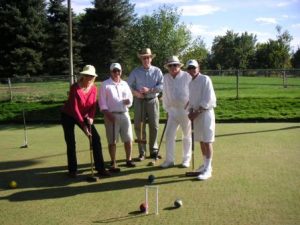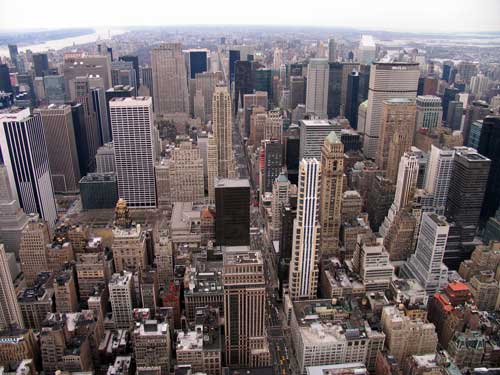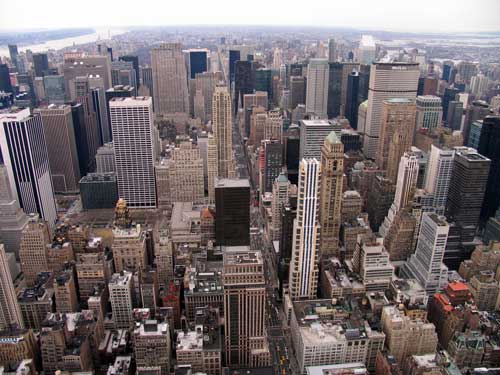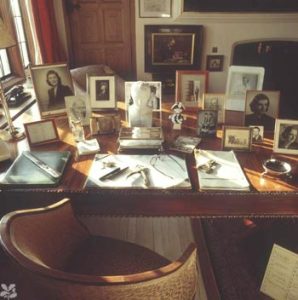
Bulletin #29 - Nov 2010
Churchill Authors Celia and John Lee Hit New York Running

November 8, 2010
NEW YORK CHURCHILLIANS
By Tina Santi Flaherty
What is it about Winston Churchill that turns us all into Energizer bunnies at one time or the other? Perhaps it’s his gargantuan appetite for life–the best of it, the all of it and living it on the edge–that charges our batteries and makes us want to be in lockstep with his accelerated speed and vision.
 When Celia and John Lee, respected military historians and authors of the new book, THE CHURCHILLS: A Family Portrait, arrived in New York, I like to think that the psychic hand of Sir Winston grabbed those of John and Celia’s and didn’t let go for seven straight days. In rapid-fire succession, Celia and John spent their first two days lecturing at two of New York most prestigious private clubs, The Lotos and The University, followed by an evening presentation at Hunter College’s famous Danny Kaye Playhouse on New York’s upper east side. The audiences for all three of these lectures were mesmerized by the Lee’s scholarly presentation that challenged many of the erroneous myths perpetuated long ago by Winston Churchill’s political enemies. Attendees were particularly enthralled when Celia put on her long white gloves and tenderly held the actual Will of Lord Randolph and read passages from it. After their presentation a long line formed to purchase books, which Celia and John personally inscribed.
When Celia and John Lee, respected military historians and authors of the new book, THE CHURCHILLS: A Family Portrait, arrived in New York, I like to think that the psychic hand of Sir Winston grabbed those of John and Celia’s and didn’t let go for seven straight days. In rapid-fire succession, Celia and John spent their first two days lecturing at two of New York most prestigious private clubs, The Lotos and The University, followed by an evening presentation at Hunter College’s famous Danny Kaye Playhouse on New York’s upper east side. The audiences for all three of these lectures were mesmerized by the Lee’s scholarly presentation that challenged many of the erroneous myths perpetuated long ago by Winston Churchill’s political enemies. Attendees were particularly enthralled when Celia put on her long white gloves and tenderly held the actual Will of Lord Randolph and read passages from it. After their presentation a long line formed to purchase books, which Celia and John personally inscribed.
I had heard about the Lee’s new book from my friend Basia Hamilton, the glorious portrait artist and the wife of Ian Hamilton, the great nephew of Churchill’s good friend, General Sir Ian Hamilton. Previously the Lees had each written books about Sir Ian and his wife, Jean. I asked Basia, who has painted the portraits of everyone from the Queen Mother, Pope John Paul II, to “Fergie,” The Duchess of York (and lesser lights, like me and my dogs), if she knew the Lees and could she possibly find a way for me to meet them on the phone. “Absolutely and consider it done, ” she replied, not bothering to tell me that it was she who had introduced the Lee’s to Peregrine Churchill, the son of Winston’s brother, Jack. Peregrine wanted the Lees assistance to help him organize his large collection of Churchill family papers and other memorabilia that he had on hand.
The Lees were given private access to family archives of letters and diaries never before seen, and kept secret for years in a locked room in Peregrine’s house. Originally Peregrine had intended to write his own book about his father as he felt that Jack Churchill’s supportive role in Winston’s career success had never been fully acknowledged, and asked the Lees to help him sort out and arrange the thousands of documents that he had accumulated over the years. When Peregrine died suddenly in 2002, Yvonne Churchill, Peregrine’s widow, asked Celia and John to write the book that Peregrine had intended to do. In preparation, Celia spent five years sifting through the goldmine of papers entrusted to her by Yvonne.

2025 International Churchill Conference
As the newspaper reviews I had read mentioned the Lees’ recent book contained a great deal of new material about the Churchill family, not previously available, I thought they would be very viable candidates to lecture at the “Irish Voice Literary Series”, which I underwrite at Hunter College. In the past, we have always featured either Irish-American authors or those born in Ireland, but I had no idea about John and Celia’s family roots. Since the inception of the Series in 2007, we have had the great privilege of hosting authors ranging from the Pulitzer Prize Winner Frank McCourt and his brothers to the great Irish writer Edna O’Brien as well as Joseph O’Neill who was on the shortlist for the Man Booker Prize for his book, Netherland. Kathleen Kennedy, the niece of President John F. Kennedy, and the daughter of the late Senator Robert F. Kennedy and his wife, Ethel, was also a key participant in the Series.
When we spoke Celia quickly assured me that she and John had definite Irish roots, as she was born outside of Portaferry in County Down and that her husband’s grandfather on his mother’s side came from County Cork. Immediately I invited them to lecture at Hunter College in October, which they graciously accepted. I think Celia and John may have originally thought that their presentation at Hunter College was all they would be doing in New York. Little did they know that my energy level is also quite high, and that I work so far into the night that my 20 year old interns exasperatingly tell me, “When we get to be your age we’re not going to work so hard.” As I was willing to do whatever it took to make every minute of the Lees first visit to New York worth their while, I wrote about one hundred emails to The Lotos and University Clubs, as well as to The Writing Center at Hunter College to create as full a schedule as possible for them. Celia, a prolific communicator on her own, must have written me at least as many in reply to my myriad questions.
The same evening as their lecture at Hunter College, I gave a party afterwards at my home in Celia and John’s honor to meet some of New York’s literary community. Never before have I given a party in which my guests were so engaged, as the subject of Winston Churchill always seems to fascinate and never bores. After I toasted the Lees, some of my guests shared their childhood memories of living through The Blitz, while others talked about Sir Winston’s courage throughout the Battle of Omdurman.
Perhaps Sir Winston’s matchless energy level somehow inspired the Lees into engaging in three more days of non-stop activity, which included a visit to the area where the former home of Sir Winston’s mother, Jennie, Lady Randolph Spencer-Churchill, was located at 41 Madison Avenue at 26th Street. Jennie lived there until she was thirteen years old with her mother, father, and sisters. Known as the Jerome Mansion, this massive structure boasted a six-hundred-person theater, a breakfast room that seated seventy people, and a white and gold ballroom complete with fountains that alternately spouted champagne and cologne. Although the building was given landmark status in 1965, the Landmark’s Commission permitted it to be torn down two years later in 1967, when the owners were unable to find a buyer.
The same evening, Randall Baker, co-president of the New York Churchillians, and his wife Elena, invited us to a private dinner at the 21 Club where we sat at the favorite table of former President Richard Nixon, who upon meeting Sir Winston in 1954, called the British leader “the largest human being of our time.” Nixon once said that he wished he could make a speech like Churchill. In a memo he wrote to his top aides, he commented, “Now I don’t mean to suggest that I should write or sound like Churchill. He is one of those rare birds where God broke the mold when he died. On the other hand, we can at least learn from him.”
On another night, I thought Celia and John would enjoy meeting my friends, Joan and Rivington (“Riv”) Winant. Riv’s distinguished father, John Winant, served as the US ambassador to Britain during the Churchill war years and was a great friend to Sir Winston’s. Ambassador Winant, beloved by the British people, did much to help forge the important relationship between British Prime Minister, Winston Churchill, and U.S. President, Franklin D. Roosevelt. I selected The Lotos Club, one of the oldest literary clubs in the United States, to host a private dinner for Celia and John to meet the Winants. The dinner was held in the Club’s famous Grill Room, where the paintings of voluptuous, turn-of-the-century women vie with the club’s equally famous wine list. After four hours, a champagne toast, six bottles of wine, caviar and crème fraiche starters and beef wellington entrees, we thought we did the memory of Sir Winston’s gourmet taste for good conversation, food and wine, justice.
From what Celia and John tell me, they left New York feeling that their book had wide and positive exposure, and that they had made many new friends for the Churchill family name. Most importantly, their lectures helped restore Jack Churchill’s rightful place in the Churchill family lore. Allen Packwood, Director of the Churchill Archive Center, where Peregrine’s papers now reside, commented, ” There have been biographies of Lord Randolph, Lady Randolph, and Winston, but what this does is to draw this all together and show how they interacted…If you really want to understand Winston Churchill you need to understand the family environment.”
Thanks to Celia and John Lee we have a greater and more accurate understanding of the family dynamic plus a new and well-deserved respect for Winston’s brother, Jack Churchill, about whom many people never previously knew existed.
Subscribe
WANT MORE?
Get the Churchill Bulletin delivered to your inbox once a month.





